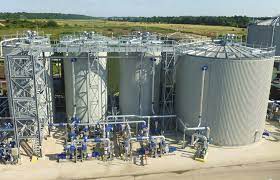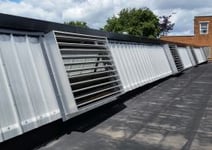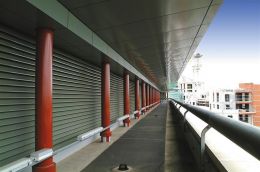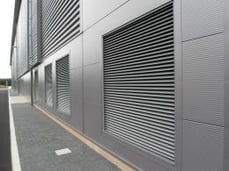 Colt has worked on numerous wastewater and sewage treatment plant projects and has an advanced understanding of the ventilation strategies and regulations surrounding this sector, which are often more stringent and complex than other project types. Regulations and guidance that govern design criteria in this sector often cover all elements of the building spec, including water, electrical, cables, controls, ventilation, etc. making an experienced designer and contractor extremely valuable when it comes to saving time and money.
Colt has worked on numerous wastewater and sewage treatment plant projects and has an advanced understanding of the ventilation strategies and regulations surrounding this sector, which are often more stringent and complex than other project types. Regulations and guidance that govern design criteria in this sector often cover all elements of the building spec, including water, electrical, cables, controls, ventilation, etc. making an experienced designer and contractor extremely valuable when it comes to saving time and money.
In most cases, the core ventilation ask for wastewater treatment facilities requires a hybrid system approach. Mechanical and natural ventilation systems and techniques combine to provide the right amount of climate control and ventilation to prevent overheating for both staff and equipment. Adequate, fresh air for the boiler combustion and sewage treatment processes is also extremely important.
In most cases, we would use hybrid ventilation with mechanical air supply to ensure a positive pressure and guaranteed air supply rate, with natural air extraction. Rain protection when designing ventilation systems for wastewater treatment facilities is also a major consideration – the equipment within the plants is often sensitive, as are the combustion processes they enable.
To demonstrate the ventilation challenges and design approaches associated with a typical wastewater treatment plant, we have outlined the strategies and systems we employed at a recent project at Colchester Advanced Digestion facility below.
Overcoming equipment overheating issues at Colchester Advanced Digestion Facility
Owned and maintained by Anglian Water, Colchester ADF treats 135,000 homes and businesses in and around Colchester, Essex. The Colchester facility was recently upgraded as an enhanced digestion treatment centre with capacity for 14,526 tonnes dry solids (TDS) per annum. The facility’s increased capacity provides for all indigenous sewage sludge from the works itself, expanded liquid sludge imports and a new cake import processing capability. The various sludges are blended, pasteurised, digested and finally dewatered to cake, ready for transportation off-site for use as an enhanced quality agricultural product.
Before the works, the facility comprised a conventional digestion process with limited power generation and served as a sludge reception facility for liquid and cake imports from other Anglian Water satellite sites in the locality.
Black & Veatch were selected to design and manage the construction of the new treatment process and contacted Colt with a requirement for ventilation to prevent overheating of sensitive equipment within the Boiler House and associated MCC controls room.
Working to tight design specifications, Colt manufactured, installed and commissioned a bespoke mechanical ventilation system to cool the building and provide adequate fresh air for the boiler combustion process.
The system Colt installed works on the principles of displacement ventilation whereby fresh outside air is supplied at low-level and warm air is extracted at high-level, using mechanical supply and natural extract.
 Colt chose a combination of double-bank Universal Louvre and Seefire (EuroCO) Ventilators to provide natural extract ventilation. The double-bank louvre provides Class A rain protection to BS EN 13030, ensuring no wind driven rain can enter the building, whilst also allowing excellent air-flow due to its high free-area. Seefire ventilators work as dampers to control the flow of air through the louvres, and close to reduce leakage when the system is inactive. The tough corrosion-resistant aluminium construction of both products ensures they can withstand the harsh environments that often exist on this type of site.
Colt chose a combination of double-bank Universal Louvre and Seefire (EuroCO) Ventilators to provide natural extract ventilation. The double-bank louvre provides Class A rain protection to BS EN 13030, ensuring no wind driven rain can enter the building, whilst also allowing excellent air-flow due to its high free-area. Seefire ventilators work as dampers to control the flow of air through the louvres, and close to reduce leakage when the system is inactive. The tough corrosion-resistant aluminium construction of both products ensures they can withstand the harsh environments that often exist on this type of site.
Mechanical supply air was provided by high-efficiency axial fans, which drew air from outside through triple-bank Universal Louvre panels located in the walls at low-level. The triple-bank louvre provides Class A rain protection to BS EN 13030 at up to 3.5m/s suction velocity, ensuring no rain can enter the building with both a 30mph (13m/s), wind and the suction created by the fans.


The complete system is controlled by a Form 4 Control Panel, meeting WIMES and Anglian Water Specifications. A series of temperature sensors ensures that the fans run only when required, therefore reducing power consumption and so operating costs of the system.
All equipment was installed within the walls of the building, which reduced the client's maintenance costs as equipment was easier to access and maintain in these locations.
If you are interested in learning more about any of the Colt products used on this project, please click on the product name below:
Colt Seefire Ventilators, Universal Louvre Systems, Fans, Colt Controls.
If you would like to talk to one of our climate control specialists about a wastewater treatment plant project, get in touch.
If your building is too hot or too cold, if your process gives off fume or moisture, if your product requires specific conditions during its manufacture or storage, or if noise is a concern, then we may be able to help you.
We can survey your building using a range of techniques and equipment to identify your problem. Once established, we can then recommend a solution based on proven design work.
Request a no obligation consultation with one of our technical experts
 Laurence Cockman is a Technical Manager for Colt UK Climate Control Division and specialises in the design and product application of energy efficient HVAC systems.
Laurence Cockman is a Technical Manager for Colt UK Climate Control Division and specialises in the design and product application of energy efficient HVAC systems.


